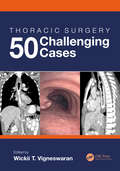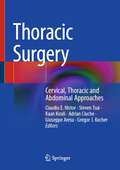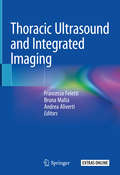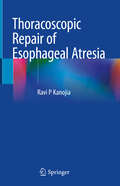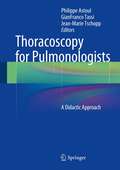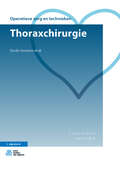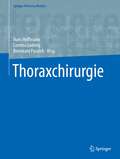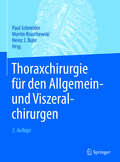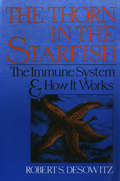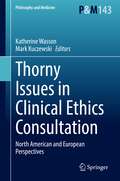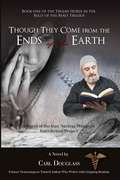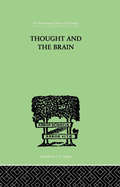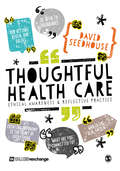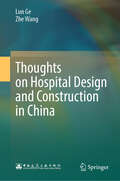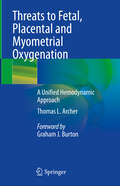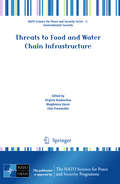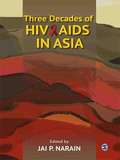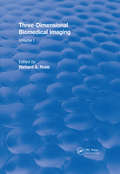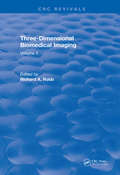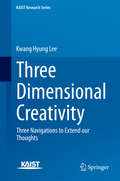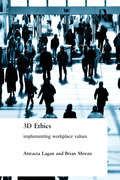- Table View
- List View
Thoracic Surgery: 50 Challenging Cases
by Wickii VigneswaranIn Thoracic Surgery: 50 Challenging Cases, editor Wickii T. Vigneswaran has selected 50 challenging cases presented by leading thoracic surgeons. Each case highlights a unique situation from which other surgeons can learn. The selection of Cases includes patients with diagnostic challenges, unconventional and innovative solutions, unexpected findings, and new techniques to treat old problems. The discussions after each case provide a useful starting point for further inquiry. Amply illustrated, this book reflects the wisdom and experience of world leaders in thoracic surgery and teaches junior surgeons how to approach the key thoracic surgical procedures, and how to manage in unexpected and difficult situations. This is a Masterclass in thoracic surgery.
Thoracic Surgery: Cervical, Thoracic and Abdominal Approaches
by Claudiu E. Nistor Steven Tsui Kaan Kırali Adrian Ciuche Giuseppe Aresu Gregor J. KocherThis book provides a guide to the anatomy and the surgical techniques required in thoracic and cardiothoracic surgery. It discusses the advantages and disadvantages of certain surgical procedures in relation to the lymphatic system, thyroid gland, chest wall and parathyroid glands, as well as pulmonary endarterectomy. Further, it addresses intraoperative and postoperative complications, and explores newer fields like microthymectomy, microlobectomy, and pain management for thoracic surgery patients. Providing an update on the latest advances in thoracic surgery, it appeals to general, thoracic, cardiothoracic, and cardiovascular surgeons. It also offers trainees insights into the foundation of the techniques and the relevant anatomy.
Thoracic Surgical Techniques
by Francis C. Wells Aman S. CoonarThis heavily revised second edition of this book provides a comprehensive overview of both common and rarely performed thoracic surgical techniques. Techniques covered include thymectomy, left and right lower lobectomy, rib resection for empyema, median sternotomy and lung biopsies. Emphasis is focused on the practical steps necessary to successfully and reliably perform the techniques covered, while acknowledgement is also given to individual variations in how these techniques are performed. Thoracic Surgical Techniques provides a detailed clinical illustrative guide for successfully performing a range of procedures reliably. Its large number of detailed illustrations and concise technical descriptions provides an invaluable resource for all practising and trainee thoracic surgeons.
Thoracic Ultrasound and Integrated Imaging
by Andrea Aliverti Francesco Feletti Bruna MaltaThis book focuses on thoracic ultrasound, a versatile, diagnostically accurate, low-cost, noninvasive and non-ionizing imaging technique. Thanks to portable devices, the method can be used to provide quick and accurate diagnoses in emergency settings, during transport, or at the patient’s bedside in intensive care units. In addition, as a dynamic examination that allows “real-time” assessment, it can be used to optimize diagnoses, the use of respiratory support equipment, surgical interventions and physiopathological assessments, both in critical patients and those with chronic conditions. Lastly, since it avoids ionizing radiation, thoracic ultrasound offers a first-line diagnostic tool for thoracic disease assessment in connection with pregnancy, neonatology and pediatrics. Pursuing a practical approach, this book also addresses the technological components that are needed in order to adequately set up the equipment. This integrated approach provides non-radiologists with essential know-how on using thoracic ultrasound as an extension of their physical examinations. Specific chapters are dedicated to thoracic ultrasound applications in neonatology, pediatrics and emergency medicine, as well as guided procedures and diaphragm function studies. Thoracic ultrasound has been a central element in the editors’ clinical and experimental work for several years, and the book also includes contributions by prominent international experts on specific applications. Given its content and scope, the book will be of interest to all medical practitioners seeking a practical approach to thoracic ultrasound.
Thoracoscopic Repair of Esophageal Atresia
by Ravi P KanojiaEsophageal atresia is a common neonatal emergency, and surgical repair in the newborn period is conventionally achieved by thoracotomy. With the development in pediatric minimal access surgery, esophageal atresia repair has been done with thoracoscopy after its first description in 1999. Many centers now prefer the thoracoscopic approach, which is claimed to be beneficial in terms of outcome both in the short and long term. Neonatal thoracoscopy is a difficult procedure and has a long learning curve. It requires a team approach with a competent anesthetist and surgical assistant. A surgeon alone cannot accomplish this procedure. This book presents comprehensive details on the procedure of thoracoscopic repair of esophageal atresia. The chapters sequentially explain all the procedure steps, from setup, instrumentation, patient selection, and ergonomics to detailed stepwise descriptions of the operative procedure. Since esophageal atresia can have so many variations in anatomy, the chapters cover how to tackle these variations. To keep the reader's interest, a detailed review of history and current literature, along with controversies, is presented. Interested readers will start from the history as the first chapter and can go through the descriptions of the entire procedure from start to finish. Any Pediatric surgery trainee interested in Pediatric Minimal access discipline will find this book as a one-stop resource on everything he wants to know about Thoracoscopic repair of esophageal atresia. The book also includes coverage of non-surgical aspects such as anesthesia and ventilation and effects on cerebral oxygenation during thoracoscopy. The book provides easy-to-understand English and is richly supplemented with illustrations and high-resolution operative photographs. Video clips also supplement the text wherever an operative step is explained. These videos are linked to the publisher’s website for easy access.
Thoracoscopy for Pulmonologists: A Didactic Approach
by Gianfranco Tassi Jean-Marie Tschopp Philippe AstoulThere is an increasing need for medical thoracoscopy performed by pulmonologists, which may be video assisted and has the advantage of being very cost-effective. This book is a comprehensive and up-to-date guide to thoracoscopy for pulmonologists that documents the considerable progress in endoscopic telescopes and instrumentation. Clear practical guidance is provided on technique, and diagnostic, therapeutic, and interventional applications of thoracoscopy are all carefully examined with the aid of high-quality illustrations. Although medical thoracoscopy is much less invasive than thoracotomy, complications can occur in a small number of cases; these are discussed and advice on prevention is provided. The concluding section examines the future of the field, covering developments such as 'mini' thoracoscopy, autofluorescence thoracoscopy, and flexi-rigid thoracoscopy.
Thoraxchirurgie (Operatieve zorg en technieken)
by Jeanette Beukema Daniël PollackDit boek beschrijft de basisprincipes en -procedures van thoraxchirurgie, de meest voorkomende operaties in het specialisme en alle aspecten van de zorg op de operatiekamer die daarbij horen. Het boek is geschreven voor operatieassistenten in opleiding. Het leerboek is ook geschikt als naslagwerk voor gediplomeerd operatieassistenten en andere beroepsgroepen in de gezondheidszorg.Het boek is opgebouwd uit vijf delen. Het eerste deel behelst algemene informatie omtrent geschiedenis van de thoraxchirurgie, de anatomie van thorax en hart, de diagnostiek en een beschrijving van de standaard openhartoperatie. Hierbij wordt ook de speciale apparatuur van de cardiothoracale operatiekamer behandeld. Deel 2 houdt zich bezig met specifieke ingrepen aan het hart, namelijk de coronaire bypassoperaties, een tweetal hartklepoperaties en de aortachirurgie. Longchirurgische ingrepen worden in deel 3 beschreven. In deel 4 staan de transplantaties en de mogelijkheden voor mechanische ondersteuning van hart en/of longen binnen het specialisme thoraxchirurgie centraal. Deel 5 gaat over minimaalinvasieve en endoscopische technieken. Thoraxchirurgie is onderdeel van de reeks operatieve zorg en technieken en is bestemd voor de opleiding tot operatieassistent. Naast het basisboek bestaat de reeks uit een aantal vervolgdelen, waarin de verschillende chirurgische subspecialismen van de chirurgie worden behandeld. De reeks benadert de beroepsuitoefening van de operatieassistent zo dicht mogelijk, waarbij de talrijke gebruikte afbeeldingende benaderingen onderbouwen.
Thoraxchirurgie (Springer Reference Medizin)
by Hans Hoffmann Corinna Ludwig Bernward PasslickZahlreiche Experten haben in Kooperation mit der Deutschen Gesellschaft für Thoraxchirurgie zu der umfassenden und praxisnahen Darstellung des Fachgebietes in allen Facetten beigetragen. Alle relevanten thoraxchirurgischen Erkrankungen und ihre Therapie sind detailliert und fundiert beschrieben: diagnostisches Vorgehen, Indikationsstellung zur Therapie, Auswahl und Durchführung des geeigneten Eingriffs, postoperative Betreuung, Krankheitsverlauf und Prognose.Seltene Erkrankungen und Krankheitsformen werden ausführlich berücksichtigt. Zahlreiche Abbildungen und Zeichnungen tragen zur Anschaulichkeit und zum Verständnis der chirurgischen Anatomie, der Krankheitsentstehung und des operativen Vorgehens bei.Das Buch sieht sich in der Tradition des 1991 im gleichen Verlag erschienenen Werkes „Lunge und Mediastinum“. Parallel zur gedruckten Ausgabe erscheint eine online-Version, die als Live Reference-Ausgabe kontinuierlich aktualisiert wird.Auch bei komplexen Fragestellungen: immer die richtige Antwort!
Thoraxchirurgie für den Allgemein- und Viszeralchirurgen
by Paul Schneider Martin Kruschewski Heinz J. BuhrIn 26 präzisen und praxisnahen Kapiteln fasst dieses Buch das Wissen zusammen, das Allgemein- und Viszeralchirurgen in der Weiterbildung und in ihrem klinischen Alltag zu thoraxchirurgischen Fragestellungen benötigen. Neben der Diagnostik und speziellen Techniken werden die Themenkomplexe thorakale Notfälle und Traumata, Entzündungen und Neoplasien ausführlich behandelt. Die möglichen Vorgehensweisen und die Auswahl der adäquaten Therapie sind dargestellt, die wichtigsten Eingriffe in Wort und Bild ausführlich beschrieben, ebenso die thorakale Bildgebung, das spezifische perioperative Management und spezielle thoraxchirurgische Instrumentarien und Techniken. Die 2. Auflage geht zusätzlich auf Tumoren und Verletzungen des Ösophagus ein.
Thorn in the Starfish: The Immune System And How It Works
by Robert S. Desowitz“Gives the reader the feeling of being granted a ringside seat to an exciting series of events. . . .This eminent scientist and writer conveys his enthusiasm for the subject. . . .He has managed to entertain, educate, and enthuse without either trivializing the complexity of the subject or underestimating the intelligence of the reader.” —British Medical Journal Dr. Desowitz describes the revolutionary discoveries made by Jenner, Pasteur, Metchnikoff, and Ehrlich and what we know about immunology today. His topics include the role of nutrition, the challenge of developing an AIDS vaccine, and the potential of genetic-engineering techniques.
Thorny Issues in Clinical Ethics Consultation: North American and European Perspectives (Philosophy and Medicine #143)
by Katherine Wasson Mark KuczewskiThis book addresses new and evolving thorny issues in clinical ethics consultation. It is a book for our time. The contributors provide essential critical reflection on the standards and methods of training clinical ethics consultants as the field seeks to professionalize. This collection incorporates both North American and European experts, offering different perspectives on issues such as marginalized populations, the opioid epidemic, complex discharge, micro-managing families, and continually challenging issues at the end-of-life, such as determinations of brain death, physician-assisted death, and futility. The authors engage the complexities of choosing for others when making decisions for incapacitated adults and pediatric patients. This volume engages with the growing literature in these debates and offers new perspectives from both academics and practitioners. The readings are of particular interest to bioethicists, clinicians, ethics committees, and students in bioethics and beyond. These new essays advance discussions in the professionalization and certification of ethics consultants and offer crucial insights on new and evolving thorny issues in the practice of clinical ethics consultation.
Though They Come from the Ends of the Earth: A Novel of the Iran Nuclear Weapons Interdiction Project (Iran Nuclear Weapons Interdiction Project Ser. #1)
by Carl DouglassThis is the first book in the trilogy, The Trojan Horse in the Belly of the Beast, by Carl Douglass. The two young mental giants who dominate this trilogy could not have come from more different backgrounds if they had been born on separate planets. Though they come from the ends of the earth, the similarities between the two geniuses--math prodigies--are striking and of serious import to the deputy director of the defense intelligence agency of the United States. His task is to undermine and to interdict the secret Iranian project to build nuclear weapons of mass destruction--Project Jahannam Adur [Hell's Fire]. The effort to subvert the planned Iranian holocaust will eventually take more than a decade and a terrible amount of sacrifice, but it could avert a war with the potential to wreak more havoc and loss that WW I and II combined.
Thought and the Brain (International Library Of Psychology Ser.)
by Piron, HenriFirst Published in 1999. Routledge is an imprint of Taylor & Francis, an informa company.
Thoughtful Health Care: Ethical Awareness and Reflective Practice
by David SeedhouseThoughtful Health Care offers a timely antidote to a Health Care climate dominated by endless rules, regulations, mission statements and codes of practice. David Seedhouse explains how simplistic labelling, mindless targets and empty slogans have created a delusion of control and efficiency, obscuring actual patient and carer realities. Using thought-provoking examples from health care and beyond, the book advocates the restoration of thoughtfulness, creativity, and independence in health work. By reading this book, students and practitioners alike will be aided in developing their decision making and critical thinking skills, and ultimately serve those in their care better and with more honesty. The book ends with a powerful and practical toolkit that can be used thoughtfully and effectively by every open-minded health worker. Thoughtful Health Care is for any health worker committed to caring with ethical awareness and practical sensitivity.
Thoughtful Health Care: Ethical Awareness and Reflective Practice
by Professor David SeedhouseThoughtful Health Care offers a timely antidote to a climate dominated by endless rules, regulations, mission statements and codes of practice. Fixation on avoiding risk at all costs has created a checkbox culture where everyone is treated according to standardised plans. But people are complicated, and cannot be understood disconnected from the complex histories, values, and environments that shape us. Obsessive focus on ‘safety first’ has obscured this reality and drastically undervalued critical thinking and insightful practice. David Seedhouse explains how simplistic labelling, mindless targets and empty slogans have created a delusion of control and efficiency, obscuring actual patient and carer realities. Using thought-provoking examples from health care and beyond, the book advocates the restoration of thoughtfulness, creativity, and independence in health work. By reading this book, students and practitioners alike will be aided in developing their decision making and critical thinking skills, and ultimately serve those in their care better and with more honesty. The book ends with a powerful and practical toolkit that can be used thoughtfully and effectively by every open-minded health worker. Thoughtful Health Care is for any health worker committed to caring with ethical awareness and practical sensitivity.
Thoughts on Hospital Design and Construction in China
by Zhe Wang Lun GeThis book gathers the thoughts of 8 hospital presidents, 9 vice presidents focusing on construction management in hospitals, and 6 hospital architects regarding the hospital design and construction in China. These experts are from top hospitals in Beijing, Shanghai, Zhenjiang, Gansu, Shangdong, Sichuang, and Neimenggu Province and have an average of 21 years of experience managing and developing hospitals in China. The book shares their thoughts on the soul of a hospital, the history and standards of Chinese healthcare systems, and the development of environments for healthcare in China.
Thread Lifting Techniques for Facial Rejuvenation and Recontouring
by Souphiyeh SamizadehThis book provides a practical guide to thread lifting techniques for facial rejuvenation and re-contouring of the face. It systematically describes the evidence base for the use of a range of available techniques for thread lifting, providing detailed guidance on how to analyse the face, take clinical photographs and correctly apply polydioxanone (PDO) threads, polycaprolactone (PCL) threads, Silhouette Soft threads and Aptos threads. Thread Lifting Techniques for Facial Rejuvenation and Recontouring comprehensively covers the use of a range of non-surgical techniques for thread lifting and provides a valuable resource for a range of medical professionals and trainees including dermatologists, plastic surgeons, nurses and aesthetic doctors seeking an up-to-date resource on the topic.
Threat Talk: The Comparative Politics of Internet Addiction
by Mary Manjikian'Threat Talk' exposes how US and Chinese scientists and policy-makers have understood and responded to the problem of internet addiction in their societies. Is the internet good or bad for society? American analysts like Lessig and Zittrain suggest that the internet is inherently liberating and positive for society, while Morozov and Sageman warn that the internet poses risks to citizens and societies. Using a comparative framework to illustrate how the two states differ in their assessments of the risks to citizens posed by the introduction of new technology, Mary Manjikian compellingly argues that both 'risk' and 'disease' are ideas which are understood differently at different historic periods and in different cultures. Her culturalist approach claims that the internet is neither inherently helpful, nor inherently threatening. Rather, its role and the dangers it poses may be understood differently by different societies. Is the internet good or bad for society? The answer, it appears, is 'it depends'.
Threats to Fetal, Placental and Myometrial Oxygenation: A Unified Hemodynamic Approach
by Thomas L. ArcherThis book presents the theory that positional obstruction of the inferior vena cava by the gravid uterus might contribute to the causation of preeclampsia, fetal growth restriction, preterm birth, dysfunctional labor and uterine atony. Investigating this possibility is timely, since non-invasive technology now exists which detects hemodynamically significant obstruction of the inferior vena cava in real time, by relying on the fact that such obstruction causes an immediate decrease in maternal cardiac output. If further research shows that obstruction of uterine venous return at the inferior vena cava can cause maternal or fetal injury, systematic reduction of this obstruction during gestation might improve maternal and fetal outcomes. Written in a direct, informal and engaging style-- and enriched with clinical insights and abundant colorful graphics-- this thought-provoking and potentially ground-breaking work should be of interest to maternal and neonatal health professionals, including obstetricians, maternal-fetal medicine specialists, neonatologists, obstetric anesthesiologists and midwives.
Threats to Food and Water Chain Infrastructure
by Magdalena Ujevic Otto Premstaller Virginia KoukouliouThe malicious contamination of food and water supplies for terrorist purposes is a real and current threat: deliberate contamination at one location could have severe global public health, trade and consumer confidence implications. The NATO Advanced Research Workshop responded to increasing concern in many countries that chemical, biological or radionuclear agents might be used intentionally to harm civilian populations and that food and water might be used a vehicle for disseminating such agents. Throughout human history drinking water and food supplies of civilians have been the target of attacks and sabotage. Initially these targets were attacked as a part of military campaign but more recently, drinking water and food have been attacked by terrorists in order to generate fear and panic in the civilian population, to create economic disruption or to undermine the people's confidence in their government and political systems. The key to minimizing the effect of food and water terrorism is the establishment and enhancement of existing food and water safety management programs and the implementation of reasonable security measures. Prevention is best achieved through a cooperative effort such Workshops, that give the opportunity to exchange knowledge, ignite fruitful discussions, create networking contacts and finally together make the next step forwards peace and security. A detailed review of the characteristics of biological, chemical and radioactive agents that would make them attractive for use as possible weapons against a given population, as well as the potential consequence bio- or agro-terrorism attack were presented by the speakers, often using actual examples.
Three Decades of HIV/AIDS in Asia
by Jai P NarainA work by health and development experts and professionals, this well-researched compilation traces the evolving and highly dynamic nature of HIV/AIDS and its unprecedented health and development threat in Asia. Three decades of HIV/AIDS in Asia studies how the region has responded to this epidemic in the last three decades. It contains country-specific chapters on the HIV/AIDS problem--low-prevalence countries such as Bangladesh and Sri Lanka as well as countries with advanced epidemics such as Cambodia, China, India, Pakistan, Thailand and Vietnam--and the evolving response to it. There is recognition of the fact that Asia remains the hardest hit after Africa. The lesson learnt from the Asian countries show that HIV can be prevented and clinically managed with sustained political commitment, adequate human and financial resources, and inter-sectoral action. With the modus operandi of real-life stories and case studies, this work is highly relevant in assessing the ground reality and the measures required for effective prevention, treatment, and care across the continuum.
Three Dimensional Biomedical Imaging: Volume I (CRC Press Revivals)
by Richard A. RobbThe best known of the new 3-D imaging modalities is X-ray computed tomography , but exciting progress has been made and practical systems developed in 3-D imaging with radioisotopes, ultrasound, and nuclear magnetic resonance (NMR). These volumes will feature up-to-date reviews by leading scientists in each of these imaging areas, providing a timely and informative comparison of the intrinsic capabilities, complementary attributes, advantages and limitations, and medical significance among the different three-dimensional medical imaging modalities.
Three Dimensional Biomedical Imaging: Volume II (CRC Press Revivals)
by Richard A. RobbThe best known of the new 3-D imaging modalities is X-ray computed tomography, but exciting progress has been made and practical systems developed in 3-D imaging with radioisotopes, ultrasound, and nuclear magnetic resonance (NMR). These volumes will feature up-to-date reviews by leading scientists in each of these imaging areas, providing a timely and informative comparison of the intrinsic capabilities, complementary attributes, advantages and limitations, and medical significance among the different three-dimensional medical imaging modalities.
Three Dimensional Creativity
by Kwang Hyung LeeIs creativity something that we are simply born with and cannot hone with effort? Some say that creativity cannot be cultivated. Is it true? In general our thinking sticks to reality unless there is any external stimulation. With our thinking fixed on a certain situation, it becomes difficult to come up with a fresh idea. In this regard, three questions are suggested: (1) Question of Time: When a problem arises, question yourself on a time axis first of all. How would the matter be handled 10 or 20 years from now? (2) Question of Space: Ask yourself some questions on its spatial elements. How would the matter be handled in Saudi Arabia or in China? (3) Question of Field: Apply the given problem in a variety of fields. How would the matter be handled in the field of music or electronic engineering? The three questions suggested here are given on the three axes: time, space, and field, and this book deals with theoretical and practical aspects on the topics. In this way it is a unique book about the systematic method of developing creativity, which will have appeal to researchers and students in multidisciplinary fields from neuroscience to physics, and engineering and computer science, as well as a general public.
Three Dimensional Ethics: Implementing Workplace Values
by Brian Moran Attracta LaganEthics is not just about morality; it is a complex dimension of personal and corporate life that can lead to higher performance by both business and society. Customers, employees and business partners seek predictable corporate behaviour that is aligned with stated personal, workplace and democratic values. Ethics training can help to achieve this. This business ethics primer is a valuable tool for raising ethical awareness in your organisation. Reflecting on employees' personal values and world views, it then examines their impact on the development and application of your organisation's mission, vision and values and finally, your organisation's impact on the societies and environment in which it operates. Three Dimensional Ethics: Implementing Workplace Values concludes with a unique chapter on ethics and doing business in China, illuminating roles in corporate stakeholder responsibility that align with principles in the Confucian Analects. Lagan and Moran provide a practical perspective on business ethics training that is lively, relevant and useful with insights into managing corporate values such as: Ethical frameworks Ladder of escalation options Ethical dilemmas Ethical decision making models Ethics audits Codes of ethics and Codes of conduct Vision and values models Stakeholder commitment steps Governance checklists Addressing values gaps Knowing your values The four virtues Stages of moral development Reflection and action Training tools include Australian and global case studies, definitions, tips, snapshots of ethical approaches, models, quotes, checklists, discussion panels, workshops, scenarios and exercises.
